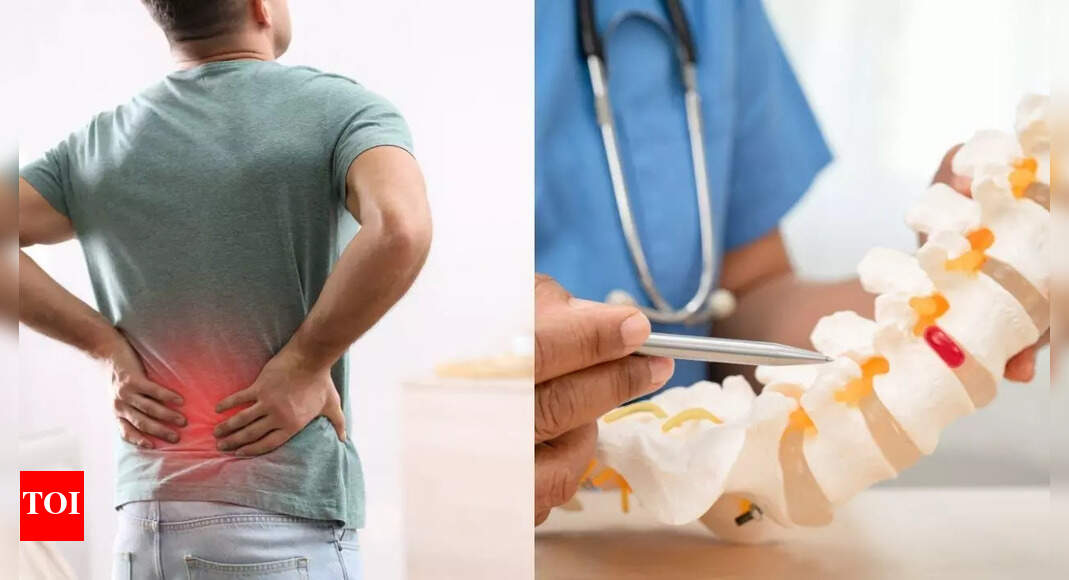Health
Distinguishing Back Pain from Slipped Discs: Key Insights

Back pain is a common complaint affecting millions globally, often resulting from factors such as muscle strain or poor posture. While most cases of back pain can be managed with simple care and lifestyle adjustments, it is important to distinguish it from a more serious condition known as a slipped disc. A slipped disc occurs when a spinal disc presses against nearby nerves, leading to a distinct set of symptoms that require prompt medical attention.
Understanding the differences between general back pain and a slipped disc can significantly influence treatment decisions. Recognizing the specific symptoms associated with a slipped disc is crucial for timely intervention, which can help prevent long-term complications.
Common Causes and Symptoms
Back pain typically arises from muscle overexertion, improper lifting techniques, or prolonged periods of poor posture. Symptoms may include localized pain, stiffness, or discomfort, which usually improve with rest, physical therapy, or over-the-counter pain relievers.
In contrast, a slipped disc presents symptoms that are more severe and may include radiating pain that travels down the leg, numbness, or weakness in the affected limb. According to the American Academy of Orthopaedic Surgeons, these symptoms occur because the protruding disc material can compress spinal nerves, leading to significant neurological effects. Patients may also experience difficulty in controlling bladder or bowel function, which necessitates immediate medical evaluation.
Importance of Professional Diagnosis
Given the potential for serious complications associated with a slipped disc, individuals experiencing acute or worsening symptoms should seek medical advice. Health professionals typically employ imaging techniques such as MRI or CT scans to assess the condition of the spinal discs and adjacent structures.
Prompt diagnosis and treatment of a slipped disc can lead to better outcomes. Treatment options may include physical therapy, medication, or, in severe cases, surgical intervention to relieve pressure on the affected nerves. The choice of treatment largely depends on the severity of symptoms and the overall health of the individual.
With the right knowledge, individuals can better understand their symptoms and seek appropriate care. It is essential to listen to one’s body and not ignore persistent or severe discomfort, as early intervention can play a critical role in recovery and maintaining mobility.
In summary, while back pain is prevalent and often manageable, recognizing when it may indicate a more serious issue such as a slipped disc is vital. Understanding the symptoms and seeking timely medical advice can lead to effective treatment and prevent long-term health challenges.
-

 World5 months ago
World5 months agoSBI Announces QIP Floor Price at ₹811.05 Per Share
-

 Lifestyle5 months ago
Lifestyle5 months agoCept Unveils ₹3.1 Crore Urban Mobility Plan for Sustainable Growth
-

 Science4 months ago
Science4 months agoNew Blood Group Discovered in South Indian Woman at Rotary Centre
-

 World5 months ago
World5 months agoTorrential Rains Cause Flash Flooding in New York and New Jersey
-

 Top Stories5 months ago
Top Stories5 months agoKonkani Cultural Organisation to Host Pearl Jubilee in Abu Dhabi
-

 Sports4 months ago
Sports4 months agoBroad Advocates for Bowling Change Ahead of Final Test Against India
-

 Science5 months ago
Science5 months agoNothing Headphone 1 Review: A Bold Contender in Audio Design
-

 Top Stories5 months ago
Top Stories5 months agoAir India Crash Investigation Highlights Boeing Fuel Switch Concerns
-

 Business5 months ago
Business5 months agoIndian Stock Market Rebounds: Sensex and Nifty Rise After Four-Day Decline
-

 Sports4 months ago
Sports4 months agoCristian Totti Retires at 19: Pressure of Fame Takes Toll
-

 Politics5 months ago
Politics5 months agoAbandoned Doberman Finds New Home After Journey to Prague
-

 Top Stories5 months ago
Top Stories5 months agoPatna Bank Manager Abhishek Varun Found Dead in Well









